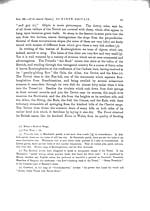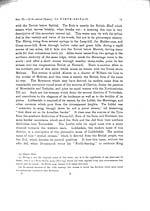Volume 3
(83) Page 72
Download files
Individual page:
Thumbnail gallery: Grid view | List view

72 its fertile haughs (t), The Ale rises from Ale-moor in Selkirkshire, and coursing through Roxburghshire for twenty miles it mingles with the Teviot below Ancrum(u). The Borthwick water, which derived its modern name from a place on its borders, rises in Craikmuir on the south-east extremity of Selkirkshire, and flowing through a pastoral country closes its course of thirteen miles by mingling with the Teviot below " the braes of Branxholm." The Kale rises from the northern declivity of the same Cheviot mountains which send the Northumbrian Cocquet to the southward, and quitting the hilly regions the Kale meanders through a spacious plain till it mixes with the Teviot below Eckford-mill after a course of eighteen miles through many clumps of full grown trees. The Kale derived its ancient name from the woody coverts which embellished its banks; Cell and Celli in the British signify- ing a grove, and Coille in the Gaelic a wood. Oxnam water also descends from those border mountains, and passing Oxnam, whence it borrowed its recent name, it pursues its winding course of twelve miles till it mingles its congenerous waters below Crailing with the Teviot, the common receptacle of a million of rills. The " silvan Jed " rises from several sources in the declivity of the Carter-fell, one of the border hills, which also send from their southern declivity through Northumberland, the North-Tyne, and the Reed ; and rushing through a rocky channel and woody vales the Jed winds round the Shire town, to which it gave its well-known name of Jedworth, which cor- ruption has converted into Jedburgh, and after a rapid course of almost twenty-one miles it pours its dusky waters into the Teviot below Bonjedworth (x). The Rule rises from three sources, in the northern declivities of Winburgh-hill, Fanna-hill, and Needlaw, the same range that sends the Liddel southward to the Solway. The Rule rolls its rapid waters between well-wooded banks, and after a meandering course of twelve miles it mingles its congenerous stream (t) Ramsay, in praising " the bonny lass of Branksome," sings, " As I came in by Teviotside, and " by the braes of Branksome.'' Branksholm is a hamlet on the Teviot, in Hawick parish. (u) The Ale, which was formerly called the Alne, obtained its name from the British Al, a fluid water. This elementary word enters into the names of many waters, both in South and North- Britain. The Alna is mentioned in a charter of David L, in 1128. It is of a dark colour; it is in some parts of its course precipitous, running over a free-stone bottom ; and there is a cave in the rock as large as a common sitting-room, having in it a copious spring of pure water. (x) The Jed, which was anciently written Ged, and Gedde, may have derived its singular name from the Celtic Gaid, the plural of Gad, and signifying withes, or twigs ; and the researches of Bullet have discovered an old Celtic word Ged, for a wood. In Hertfordshire, there is a river named Gade, and in Aberdeenshire a Gadie.
Set display mode to:
![]() Universal Viewer |
Universal Viewer | ![]() Mirador |
Large image | Transcription
Mirador |
Large image | Transcription
Images and transcriptions on this page, including medium image downloads, may be used under the Creative Commons Attribution 4.0 International Licence unless otherwise stated. ![]()
| Caledonia, or, An account, historical and topographic of North Britain from the most ancient to the present times > Volume 3 > (83) Page 72 |
|---|
| Permanent URL | https://digital.nls.uk/74528240 |
|---|---|
| Description | Vol. III. |
|---|---|
| Attribution and copyright: |
|

